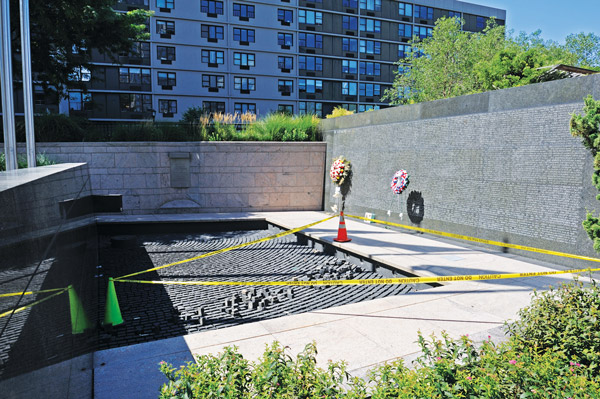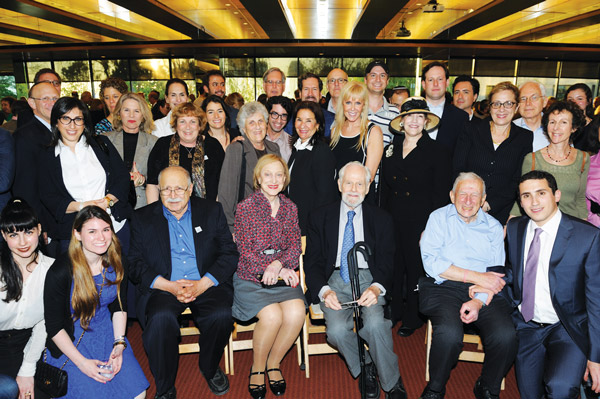
Electrical installation at the Police Memorial postponed:
Superstorm Sandy dumped around nine feet of water into the vault that holds the electrical equipment for the New York City Police Memorial fountain, for the Kowsky Plaza dog run and for the playground known as “Pumpkin Park.” The equipment hasn’t worked since.
Recently, the Battery Park City Authority issued an R.F.P. to replace the electrical system and got one proposal — from D’Onofrio General Contractors Corp. Its bid of $532,000 for the job was acceptable and the repairs could have started immediately, but they won’t.
“So we’re going to do all this just in time for the new hurricane season?” B.P.C.A. chairperson Dennis Mehiel asked Gwen Dawson, who is in charge of asset management for the authority. “I would just feel like a moron if we finish this thing on Oct. 15 and on Nov. 1 we had 12 feet of water.”
Board member Martha Gallo suggested that it might be better to wait a couple of months, or possibly until spring.
After some discussion, the board determined that that would be an excellent idea. The equipment will be ordered immediately because it takes awhile to obtain, but it won’t be installed until after Nov. 15, when presumably the hurricane season will have passed.
In the meantime, there are two important commemorations at the Police Memorial – one on September 11 and one on October 11, when police officers who have died in the line of duty are remembered. Dawson said that all of the stones in the pool at the memorial are currently being cleaned and reset. For the commemorative occasions, the pool will be filled with water, but it will not course along the side of the memorial and flow into the pool as it did before Sandy.
Eventually, a new, above-ground vault will be built for the electrical equipment, but it will take awhile to prepare a site for it and to design it. Besides, Dawson explained, the insurance company would only pay to replace exactly what had been there before, not an improvement. Dawson said that it’s possible that FEMA [the Federal Emergency Management Agency] will pick up some of the cost of a new structure.
Dawson told the board that the Police Memorial electrical system is not the only storm-vulnerable part of the Battery Park City infrastructure. “There are a number of things we will not be completely ready for in terms of major storm events for a little while,” she said. “It may be months, it may be a number of months. In some cases, it may be closer to a year.”
Funding for Connection bus approved:
Since its inception in 2003, the Battery Park City Authority has helped to fund the free Connection shuttle bus service run by the Downtown Alliance. Since 2010, it has been costing the B.P.C.A. $632,000 a year. That funding was questioned at a board meeting earlier in the year, apparently because the New York State Inspector General had cracked down on the authority for making contributions to things not directly associated with its mission, which is “to plan, create, co-ordinate and maintain a balanced community of commercial, residential, retail, and park space within its designated 92-acre site on the lower west side of Manhattan.”
The shuttle bus runs daily between the South Street Seaport and Broadway near City Hall and is heavily used by Battery Park City residents. The board has decided to renew its funding for the 2013 calendar year but is tying its allocation to the service rendered. “All funds given to the Alliance must be used for additional bus service,” said Anne Fenton, who introduced the shuttle bus topic at the board of directors meeting on July 30. “Any funds not used for that purpose must be returned to the Battery Park City Authority.”
This is the first time that the money has been given with this stipulation. Previously, it had been described as a “contribution” although it was actually a fee for service.
It costs approximately $2 million a year to run the shuttle bus service. Chairperson Mehiel wondered how the Downtown Alliance went about selecting the bus vendor and whether there might be another company that would offer an equivalent service for less money. He said that the B.P.C.A. would look into that in the future.
New member of Battery Park City Authority Board:
At the B.P.C.A. board of directors meeting on July 30, Mehiel welcomed Lester Petracca to the board. Petracca is president of Triangle Equities, a real estate company that develops, owns and manages commercial, residential and mixed-use properties in the New York metropolitan area. His company is an outgrowth of a construction company founded by his family in 1916. His nomination to the B.P.C.A. board was approved by the New York State Senate on June 20. The B.P.C.A. board is supposed to have seven members. Petracca replaces Robert Mueller, who left the board in April 2012.

‘Against the Odds’ at the Museum of Jewish Heritage:
At a time when immigration reform is front-page news, an exhibit at the Museum of Jewish Heritage in Battery Park City has particular resonance.
“Against the Odds: American Jews and the Rescue of Europe’s Refugees, 1933-1941” tells the story of the Jews who managed to escape from the persecutions that began in Nazi Germany in 1933.
“Most countries refused to accept large numbers of Jewish refugees,” the exhibit’s signage says. “Many German Jews hoped to come to the United States, but laws passed by Congress in the 1920s had ended the era of open immigration. The new policy set strict quotas that made no special allowances for refugees. Jews in flight from the Nazi regime reached out to family, friends, and strangers in America, whose sponsorship was essential if they hoped to secure U.S. visas.”
By 1941, it was no longer possible to escape. An estimated six million Jews died in the Holocaust.
When the exhibit opened, former New York City district attorney Robert Morgenthau introduced it. “There are many here tonight who are related to American Jews who went to great lengths to bring people to safety from Nazi domination in Europe,” he remarked.
Among them were descendants of William Thalhimer, Sr., a department store owner in Richmond, Va. In 1938, he bought a farm called Hyde Farm in Burkeville, Va. and was able to rescue about 36 German-Jewish teenagers who were from an agricultural school in Gross Breesen, Germany — now Poland.
“He never spoke about the story to his grandchildren,” said Elizabeth Thalhimer Smartt, one of his great-granddaughters. But she did hear her grandfather talk about it. She thought that her great-grandfather had been disappointed that he hadn’t been able to save more people, but the people he did save have hundreds of descendants. One of them, Nadine Angress, was at the exhibit when it opened. Her father, Werner Thomas Angress, had written a book about his experiences called “Between Fear and Hope.”
“It was amazing to connect with his daughter,” Smartt said.
Jonathan Alger, the lead designer for the exhibition, said he had worked on it for the better part of a year. “The most challenging thing was to find a physical way to make a history mostly made of documents into something interesting and tangible,” he said. “At this time of history, paperwork could be the difference between life and death for people coming out of Europe.”
Among the documents in the exhibit is a letter from Albert Einstein to Eleanor Roosevelt in which he asked that she consider the plight of Jewish refugees from Europe. He entreated her to find some important people with whom to share that information in order to try to change the outcome.
Dr. Ruth Westheimer, herself a refugee, said, “What I’m particularly happy about is how many young people there are here, how many families, how many grandchildren. [A lot of people don’t know the stories because] a lot of people never talked about it.,”
The exhibit consists of film clips, documents, artifacts and interactive presentations. It will be at the Museum of Jewish Heritage, 36 Battery Place, through the spring of 2014.
To comment on Battery Park City Beat or to suggest article ideas, email TereseLoeb10@gmail.com
— BY TERESE LOEB KREUZER
































